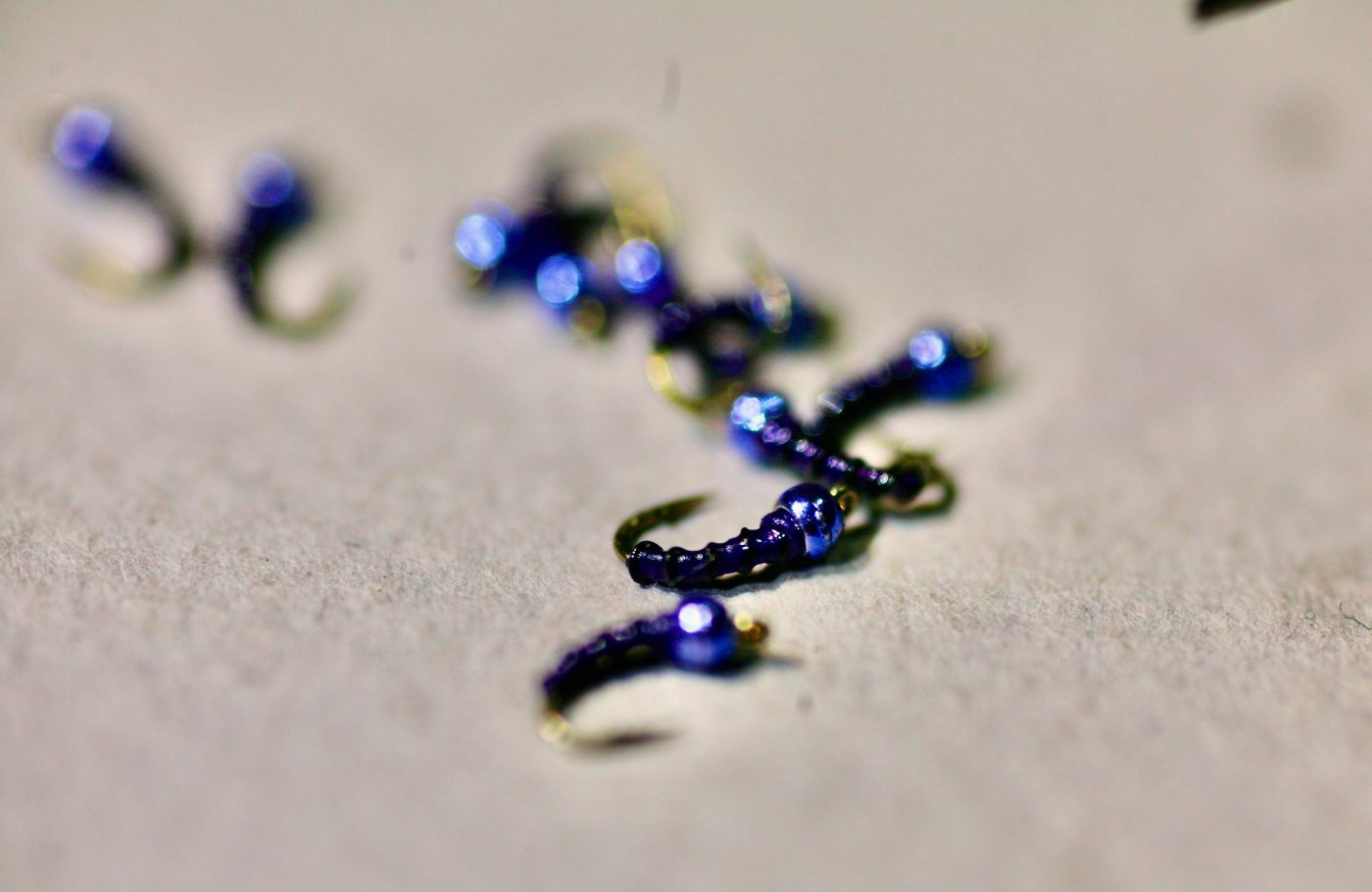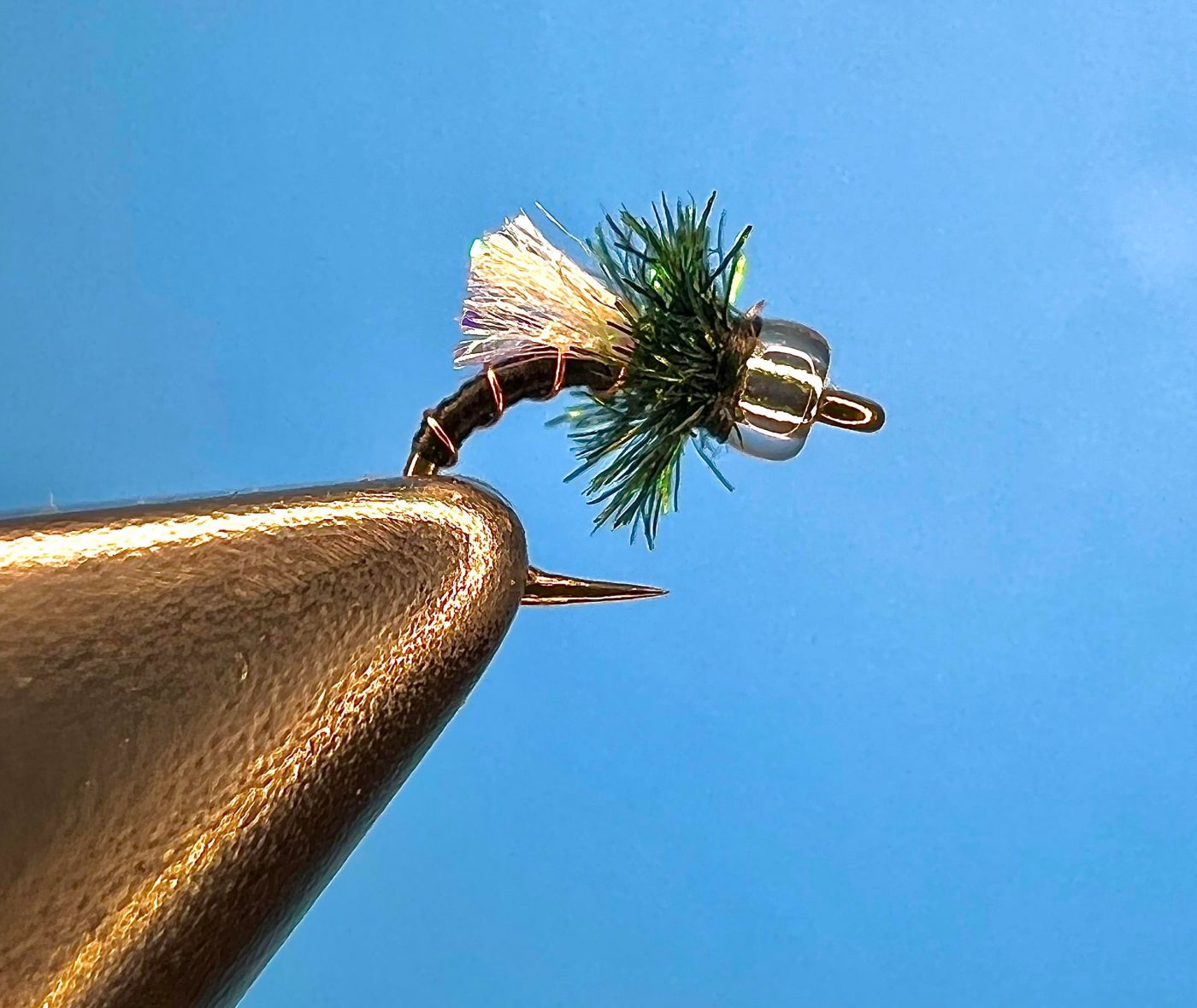Bug of the Month: The Midge
If you aren’t carrying a fly box dedicated to midge patterns, you should make a resolution for 2022 to do so. Midges are on the menu for trout 365 days a year, but because of their prominence in winter months, they get the nod for our January “Bug of the Month.” Three of our guides – Juan Ramirez, Greg Blessing, and Phil Tereyla – shared their wisdom in the development of this blog.
“I’m always amazed that really big fish will eat such a small fly,” Phil Tereyla says. “And the eyesight that fish must have when they are keying on such small bugs is pretty amazing, too.”

About the Midge
The midge has a very short life cycle. Unlike some other insect species that may take a year or so to evolve, midges develop very quickly. They move from egg-larva-pupae-adult in just a few weeks. Because of this rapid maturation, it’s important to be dialed in so you can adjust for depth, weight, and pattern selection.
For midges, it helps to have an extensive knowledge and a deep fly box to match. It may even help to think of the life cycle as larva, pupae/emerger, surface-film emerger, then adult.
As Phil says, “Focusing on what stage the midge is in is key. When they’re on larva, they’re on larva. You may need to make the change, though, and dial in to pupa and emerger stages.” In the winter months with midges, paying attention to the lifecycle becomes much more crucial for success.
Fishing the Midge
Fishing the Larva Stage
When they are in the larva stage, midges are found toward the bottom of the river, clinging to rocks or sticks, or drifting through the water. If you seine the river, you’ll see small, worm-like larva wriggling in your seining net.
In January and February, the coldest water temps means you’ll have to go really small. The middle of the day is to take advantage because bugs are moving and fish are moving.
As Greg Blessing says, “you can schedule your day around banker’s hours. You can get up late, fish from 11:00 to 2:00, and call it a day early.”
Larva can range in size from the very small 24 and 26s in January and February to the larger 18 and 20 as we move into March and April. As Juan says, “midges are always in the water but fish may not always be eating them, especially when larger bugs start to hatch.”

Fishing the Pupae Stage
In the pupa stage, midges have begun to develop legs, wings, and gills. When they shed their larvae sheath, they begin their journey to the surface. As they move up from the bottom of the river, they develop a small air bubble. Because midges are not great swimmers — they are a flying insect, after all — they are very vulnerable in this stage.
Fish are looking at that food source swimming to the surface, and they’ll get increasingly opportunistic to eat as much food as fast as they can.
It’s important for anglers to adjust for depth. You may find that you need to see if fish are feeding on larva closer to the bottom or on pupae higher in the feeding column.
An early morning rig may have larva patterns fished deep and then, as the day – and water — warms up, switching it up to a larva pattern as your first bug with a pupae pattern (or two) trailing that can be productive.
Before it becomes an adult, the pupae may struggle a bit to break through the surface. Because of that, it’s helpful to think of the pupae stage in two parts – emerging and surface emergers. Anglers can have great success by drifting the emerging pupae pattern just a few inches beneath the surface in the foam.
Greg Blessing’s approach is to “go small on the tippet and drop it down in the foam about an inch when fish start to move up in the feeding column.” He likes to begin the morning fishing three midge patterns: zebra, mercury, and the Black Beauty.
As the water temps increase, Blessing may switch out the Black Beauty for a Top Secret, or for Jon Easdon’s Blindside Midge, or even change to his own Purple Haze. “The Purple Haze blurs the line between a blue wing and a midge. Sort of a cross-over. And fish will hit it on the swing.”
Blessing and Ramirez agree that sight fishing, when it’s possible, is going to be more productive. You have to be able to see how deep the fish are, how much they’re willing to move, and notice when they start to rise in the feeding column. In the colder water, and early in the day, they are sitting deeper and may not be eating too frequently or too much.
Fishing the Adult Stage (also emergers in the foam)
As the midge shucks its pupae sheath and becomes an adult, it will sit on the surface to dry its wings.
Interestingly, often times there can be good dry fly fishing in the winter because of these adult midges. You might see a whole bunch of midges and midge clusters when the conditions are right.
Phil says, when there are midges on the surface, “I’ll skate my midge over the surface rather than always present it as a dead drift. A little motion can put your bug on display and make it stand out from another midge or midge clusters on the water.”
Another thing to observe, as Juan Ramirez emphasizes, is to study the fish rise. If you’re seeing the nose and mouth, the fish are probably feeding on the surface. But when you see the dorsal fin, or the back of the fish, break the surface, they are feeding just below the surface. “Their momentum may be carrying the fish up to the surface after they have eaten. Or you might just see a dimple on the surface rather than a nose and lips.”
As usual, reading the water is super important. Fish won’t be using a lot of energy and they’ll stay in slower, deeper water. The presentation has to be slower for two reasons. First, the water is slower. Second, the fish will not move too far to eat because of their lower metabolism and the winter doldrums.
All three guides emphasize that a key to fishing with midges is getting size and silhouette right. Of course, that is not unique to midges. In the winter months, though, when fish may be less aggressive and more selective, size and silhouette will be crucial to getting a take.
The take may be very subtle since it is not an aggressive strike. As Greg Blessing says, “if you can detect a strike in the winter on small bugs, you’ll be able to detect a more aggressive take later in the season. Fishing the winter months improves your fishing for the rest of the year.”
Tying the Midge

Fly Tying Quick Tips: The Midge
Juan Ramirez has a whole series of videos on his YouTube channel. He offers two versions of videos. One version is fast — mostly under two minutes — and experienced tiers can benefit from seeing him build the pattern. The other version is more detailed so less experienced tiers can have a nice introduction to tying some patterns. And here are some direct links to videos:
- Money Midge
- Flux Capacitor
- Krystal Flash Emerger (short)
- Pale Ale (shorter version) Pale Ale (longer version)
- Slim Rib Ninja Midge.
All three of the guides agree on one thing when it comes to tying midges: the simpler, the better. The designs are basically thread and wire. Phil adds, “The more wraps you make, the bulkier it is going to look. And I don’t use dubbing when I tie larva patterns. I just use thread.”
The key to a well-tied midge, Blessing says, is “Keep it small, keep it thin, and use very little material. Think size and silhouette. Small and skinny. Juan’s really work well because his silhouette is so skinny, so sleek.”
Final thoughts
Winter fly fishing poses challenges, for sure, but when you get dialed in to midge behavior and the fish behavior that follows, tough conditions can be productive days. Want to step up your winter fly fishing game? Sign up for our Winter Fly Fishing class and get some first-hand experience!
Coming up in the next couple of weeks, we will be posting videos on our YouTube channel. Watch there for tips and techniques for fishing the midge and a video on tips for tying midges.
Subscribe to our newsletter, subscribe to our YouTube Channel, watch this blog space, and come into the Shop to talk with our expert retail staff about winter fly fishing and midge magic.

[…] we head into and through February, the egg pattern becomes a nice variation to the small midges and winter stoneflies you may be throwing. As February will transition into March, and with it more […]